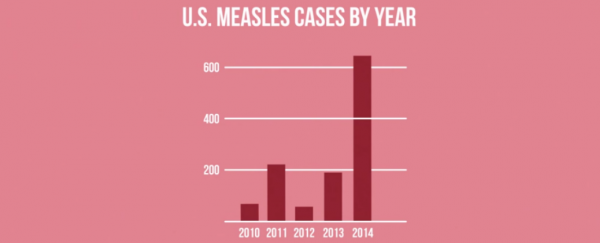If you get measles as an adult, you'll likely experience flu-like symptoms, a raised rash on the face, followed by inflammation of the eyes and terrible fevers. If you're a young child and you get measles, you might have to deal with the threat of brain damage, hearing loss, or even death.
But we know how the disease works and we've become pretty great at treating and preventing it. Back in 1996, measles was included in a list with mumps, rubella, and pertussis as an 'almost extinct disease', and by the year 2000, the US announced that they had officially eliminated it within their borders. In a medical sense, "eliminated" doesn't mean it's been wiped out completely, but that it's no longer endemic, so no longer regularly found in a certain region.
A pretty amazing achievement, sure, but measles is actually a relatively easy disease to get rid of because of the way it works. The virus goes extinct in a community after an epidemic, and another epidemic is impossible unless sparked by a new infection coming from outside. In fact, the disease had become so rare in the US, that when an outbreak appeared, it didn't take long for scientists to figure out where it had originated, says Hank Green in the latest episode of SciShow above.
But then, in December last year, a person carrying the measles virus visited Disneyland in California, and as a result, more than 100 people have been infected, and the disease has spread to 17 states around the US. "Now, 100 might not sound like a lot, but keep in mind that it's twice the number of cases the US usually sees in an entire year, and that the outbreak is only two months old," says Hank. And now there are big concerns over how far this outbreak will spread, given the rising movement against vaccinations.
So how does something like this happen?
While measles was no longer prevalent in the US, it is in any other places around the world, where it remains one of the leading causes of death for young children. For example, the Philippines is thought to be where the current US strain appears to be from. But thanks to vaccinations, worldwide measles deaths have decreased by 78 percent in the last 10 years.
As an airborne virus, measles is great at spreading, and an infected person will pass the disease on to an average of 12 to 18 people, says Hank in the episode of SciShow above. But a very effective vaccine to combat this spread has been around for the past 50 years, and it uses a small amount of live, but severely weakened, measles virus that doesn't cause any symptoms, but does stimulate the body's natural immune response to the disease. And once our bodies have learned how to do this once, they know how to do it again and again, whenever they come into contact with the disease.
So if we're all immunised, we're all protected, even if the immunisation fails for around 3 to 5 percent of the people who receive it, thanks to a concept known as 'herd immunity'. But problems occur when the amount of people immunised slips below the threshold of 92 percent. Watch SciShow above to find out why.
Source: SciShow
